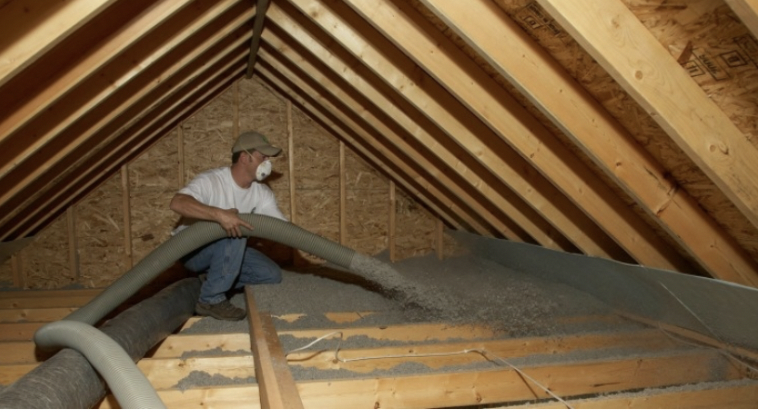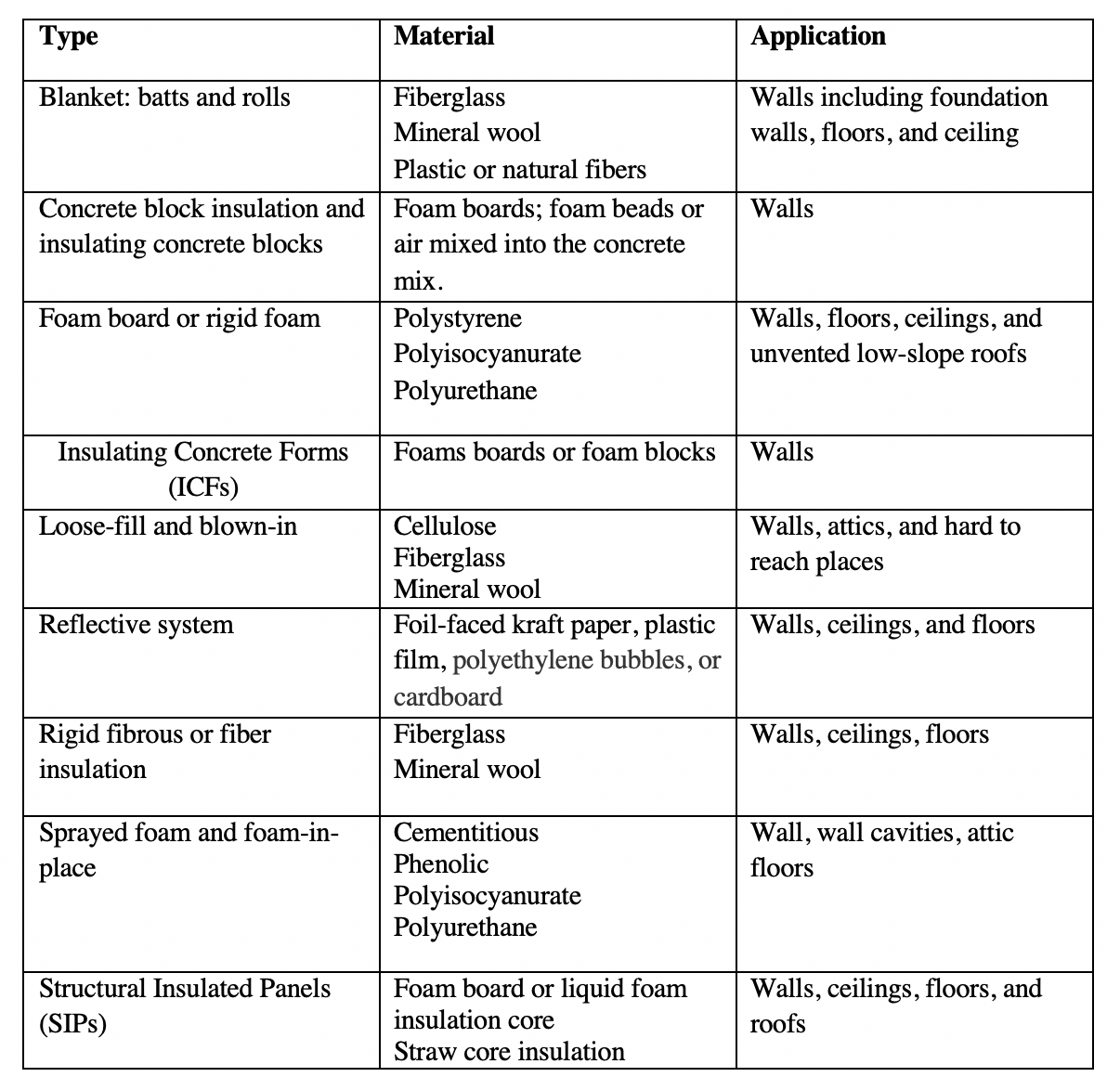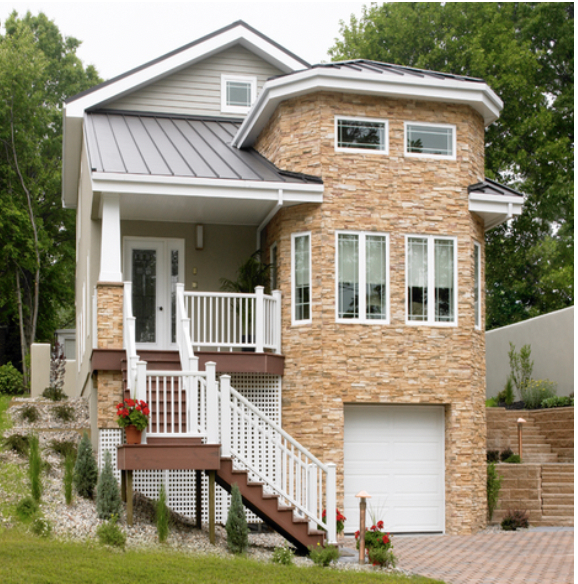Insulation
New ResidentialWhat is Insulation?
Insulation includes material that reduces the amount of heat lost from a building. Properly insulating a new home relates to creating an efficient building envelope. A properly insulated building envelope increases the efficiency of the heating, ventilation, and air-conditioning (HVAC) system, reducing energy costs while increasing occupant thermal comfort by acting as a thermal barrier and controlling indoor temperature and humidity levels. For example, in cold and damp basements, adequately insulated foundation walls and floor slabs reduce heating and cooling costs and result in more comfortable below-grade rooms. Insulation also helps prevent problems with moisture, insects, and radon in the home (see Radon Mitigation System strategy). It is important to note that insulation only helps reduce air and heat flow in the space where it is contained. Therefore it is most effective when the home is also correctly sealed against excess air infiltration (See Air Infiltration Reduction).[1] Other components of the typical building envelope include windows, doors, walls, roof, and foundation, all of which require different types of insulation.

Figure 1. Blown-in cellulose insulation in a home attic. (Source: Cellulose Insulation Manufacturers Association).
How to Insulate
A highly insulated building envelope requires an integrated design approach during the pre-design phase of a new home project that views the building as a whole system and coordinates the insulation of all the building elements (see Integrated Design Process). Consider the selection of materials used in the walls, doors, roof, windows and foundation, as well as daylighting strategies, the design of HVAC and electrical systems, and the home’s energy performance goals. For example, a highly insulated building envelope reduces the energy requirements and therefore the size of the home’s HVAC system by minimizing the loss of conditioned air to the outside (see Properly Sized HVAC Equipment).
Insulation ratings refer to R-value or resistance to heat flow. [2] An insulation’s material composition and thickness contribute to its R-value. A higher R-value indicates higher expected thermal performance. However, more is not always better, as there is a point of diminishing returns with insulation (i.e., the intersection between cost and energy savings).[3] Look for Energy Star certified insulation tested for performance and safety standards. Compare the R-value of the selected insulation to local and state building code requirements and best practice recommendations for the local climate region. The International Energy Conservation Code (IECC) Compliance Guide for Homes in New Jersey provides detailed information about the different climate zones in New Jersey and corresponding insulation standards.[4]
While fiberglass batt insulation remains popular, a growing number of other insulation options exist (see Table 1). For example, insulated concrete forms (ICFs), insulated pre-cast concrete wall systems and structural insulated panels (SIPs), provide structural support with built-in insulation.

Table 1 – Common types of insulation used in residential applications. (Source: Adapted from US DOE Types of Insulation).
Proper installation impacts the R-value of insulation. Homeowners can install some types of insulation, such as batts and rolls, but other types may require professional installation.[5] The US DOE offers the following guidelines when hiring an experienced installer:[6]
- Obtain written cost estimates based on R-value from several contractors.
- Ask contractors about air-sealing services and costs.
For more information on the different types of insulation and on hiring a professional installer, see the US DOE: Energy Savers – Types of Insulation and Energy Star websites.
Examples
BASF Near-Zero Energy Home, Paterson, NJ
BASF, a chemical company, constructed a near-zero energy, single-family model home in Paterson, New Jersey. The structure incorporates three types of insulating foam technologies to reduce energy consumption. Additionally, the building uses ENERGY STAR certified, low-e, glazed windows to block solar heat gain while allowing natural daylight into the home. Air-sealing included weather-stripping around windows and doors.

Figure 2 – The BASF Near-Zero Energy Home in Paterson, NJ
Baseline Home vs. Model of Energy Efficient New Home in NJ.
This study investigated the costs and benefits of different residential energy efficiency scenarios, including advanced framing and upgraded insulation, compared to a baseline, single-family detached home.
The basic framing/insulation upgrade used a 2×6 @ 24” on-center advance framing technique. This model upgrade included the following insulation improvements:
- Foundation walls insulated with R-20 rigid extruded polystyrene, closed-cell foam insulation.[7]
- Above-grade walls insulated with rigid foil-faced isocyanurate, a closed-cell, rigid foam insulation with an R-value of 7 per inch.[8]
Study results showed that the basic framing and insulation upgrade had a lower initial investment ($19k, or 19%) as compared to the baseline and saved approximately $300, or 9% in annual operating costs.[9]
The enhanced framing/insulation upgrade used Insulated Concrete Forms (ICFs) for the foundation walls, Structural Insulated Panels (SIPs) in the above-grade walls, upgraded ceiling insulation of R-70 blown-in cellulose, and fiberglass floor insulation with a higher R-value of 49.[10]
Study results showed that the enhanced framing and insulation upgrade cost less in initial investment ($ 1k) as compared to the baseline and saved approximately $500, or 16% in annual operating costs. [11]
Benefits
An important benefit of a properly insulated new home includes lower costs of mechanical systems. An adequately insulated new home allows for the installation of an appropriately sized HVAC system. Older, poorly insulated buildings often require oversized HVAC systems to accommodate for the loss of conditioned air through air leakage. Sealing air leaks and adding insulation can increase occupant thermal comfort and save an average of 10% on annual energy costs.[12] Properly insulated homes maintain comfortable indoor temperature and humidity levels and guard against outside noise, pollen, dust, and insects.[13]
Costs
The cost of implementing a highly insulated building envelope vary depending on the size and orientation of the home, climate, design elements, and the type of insulation and building material. Annual energy savings and incentives offered by the NJ Office of Clean Energy can help offset upfront costs.
While foam insulation products and installation typically have higher first costs compared to traditional batt insulation, foam insulation has lower life-cycle costs due to reduced construction time for installation, and the avoided costs associated with weatherizing a home (i.e., caulking, house wrapping, vapor barriers) because of its high R-value and tight air barrier.[14]
For information about costs for various insulation materials see Home Advisor: Insulation Costs: https://www.homeadvisor.com/cost/insulation/#closing-article
Resiliency
A properly insulated home offers several essential resiliency benefits. In the event of a power outage, well-insulated homes protect against heat loss in the winter and heat gain in the summer, helping to maintain comfortable internal temperatures for building occupants. Wall assembly systems (with insulating properties) such as precast concrete panels, insulated concrete forms (ICFs), and structural insulated panels (SIPs) offer resistance to hazards such as fire, wind, earthquakes, and floods, and improve indoor environmental quality through resistance to mold.[15]
[1] US DOE: Insulation Fact Sheet. 2008. https://web.ornl.gov/sci/buildings/docs/factSheets/Insulation-FactSheet-2008.pdf (accessed May 4, 2018).
[2] US DOE: Energy Saver. “Insulation” https://www.energy.gov/energysaver/weatherize/insulation (accessed May 29, 2018).
[3] Rutgers Center for Green Building (RCGB). 2011. “Costs and Benefits of Residential Energy Efficiency Investments.” Prepared for the New Jersey Association of REALTORS® Governmental Research Foundation. Page 21 http://rcgb.rutgers.edu/costs-and-benefits-of-residential-energy-efficiency-investments/ (accessed May 9, 2018).
[4] Responsible Energy Codes Alliance (RECA). International Energy Conservation Code (IECC) Compliance Guide for Homes in New Jersey. https://reca-codes.com (accessed May 4, 2018). Note: IECC Code 2015 is the current adopted NJ Building Code for New Residential Construction in NJ.
[5] Energy Star. Types of Insulation and Skill Leve Required to Install. https://www.energystar.gov/index.cfm?c=home_sealing.hm_improvement_certified_insulation (accessed May 7, 2018).
[6] US DOE: Energy Savers – Types of Insulation. https://www.energy.gov/energysaver/weatherize/insulation/types-insulation (accessed May 4, 2018).
[7] Rutgers Center for Green Building. 2011. “Costs and Benefits of Residential Energy Efficiency Investments.” Prepared for the New Jersey Association of REALTORS® Governmental Research Foundation. Page 23. http://rcgb.rutgers.edu/costs-and-benefits-of-residential-energy-efficiency-investments/ (accessed May 9, 2018).
[8] Ibid, page 24.
[9] Ibid, page 24.
[10] Ibid, page 26.
[11] Ibid, page 26-27.
[12] Energy Star. Seal and Insulate with Energy Star. https://www.energystar.gov/index.cfm?c=home_sealing.hm_improvement_seal_insulate (accessed May 7, 2018).
[13] Energy Star. Why Seal and Insulate? https://www.energystar.gov/index.cfm?c=home_sealing.hm_improvement_sealing (accessed May 7, 2018).
[14] US DOE: Energy Savers: Types of Insulation. https://www.energy.gov/energysaver/weatherize/insulation/types-insulation (accessed May 7, 2018).
[15] New Jersey Climate Adaptation Alliance (NJCAA). 2014. The Role of Buildings in Climate Adaptation. Climate Change Preparedness in New Jersey. Page 11. Edited by Jennifer Senick. https://njadapt.rutgers.edu/docman-lister/resource-pdfs/111-green-bulding/file (accessed May 7, 2018).
Related Strategies
Resources
- The Efficient Windows Collaborative: New Jersey Guide
- ENERGY STAR
- NJ’s Clean Energy Program
- North American Insulation Manufacturers Association (NAIMA)
- Responsible Energy Codes Alliance (RECA) – Compliance Guide for Homes in New Jersey to Meet the 2015 International Energy Conservation Code (IECC)
- US DOE
